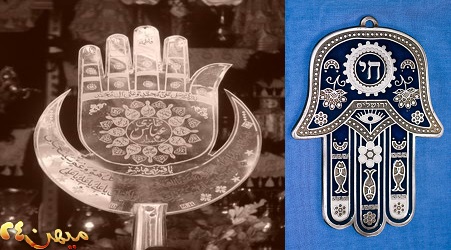
Blood shedding ritual of Tatbir in Ashura: Is it Islamic?
Posted On:In the name of Allah, the Merciful to all, the Compassionate
Tatbir (Arabic) and Zanjeer Zani (Persian) are amongst a set of bloody rituals that are performed by some Shiite Muslims in commemoration of the great tragedy of Karbala, when the family of the Holy Messenger of Allah, Muhammad (PBUH) was massacred. Such blood shedding rituals are historically not a part of Shiite Islam, and were never practiced by the founders and teachers of Shiite. There is not a single shred of evidence that the later Imams performed such blood rituals. Moreover, the most prominent Shiite scholars declare such rituals either as outright Haraam (forbidden), or in a less provocative tone, just something they do not recommend. So this question remains unanswered when such rituals are against wisdom and common sense, and there is no religious basis to support them: why people do not cease practicing them?
Where did Tatbir and Zanjir come from?
When the Roman Empire crossbred the pagan religion with Christianity and created the Catholic Church, some forms of human sacrifice practiced before were introduced to Catholicism. Reenactment of Crucifixion of Jesus Christ and self-flagellation was wide-spread among Catholics throughout history, and still is practiced in Philippines.
How did it enter Shiite culture?
Historically, the remembrance of Ashura among Shiites was more of a lamentation; reciting what happened in Ashura with weeping and moaning. Back then, people had a very high command of language and they could depict every situation using only words, in a way that no contemporary Computer Generated imagery can match. But over the course of history, such abilities gradually diminished.
So the original lamentations of Ashura work only for people who have a good grasp of history and literature, and are able to understand epic poems. But ordinary people are not sophisticated enough to appreciate such lamentations. No matter how sophisticatedly you depict in a poem the brutality of targeting with an arrow an infant’s throat, dying of thirst; illiterate people are not capable of appreciating it. But if you depict this in a drawing or by a statue, it touches their heart. Moreover, people prefer something more like a carnival; a ritual that they can watch, touch, and practice.
When the Safavid dynasty assumed the power, they were desperate to create a unique identity which separates them from Ottomans. They needed to transform Ashura to a ritual that laymen could participate in, to be able to use such rituals as a show of force. But they ran out of ideas for how to do that. According to Ali Shariati (a controversial sociologist who was reliable only in his field of expertise), Safavids sent a team to Europe in search of new ideas. That team followed a very simple procedure: they took all the rituals of commemoration of Jesus Christ's sacrifice, and transformed it to the commemoration of Imam Hussein in Ashura. Nowadays, you can find many of the ancient pagan symbolisms used in such rituals. Hamesh hand which is transformed to a symbol for the severed hands of Abalfazl-Al-Abbas is just an example. Alam (عَلَم) and Kotal are basically the same cross used by Catholics, disguised with some ornaments.

[caption id="attachment_1316" align="alignnone" width="451"] The right picture is Hamesh or Hamsa, a pagan symbol; the left is what is used as a symbol of Abalfazl's (PBUH) hand[/caption]
The right picture is Hamesh or Hamsa, a pagan symbol; the left is what is used as a symbol of Abalfazl's (PBUH) hand[/caption]
What is Shiite scholars’ decree about such bloody rituals?
Obviously, Islam is the religion of wisdom and reasoning. So such practices cannot be permissible, and the most prominent of ulama prohibited them. However, some of the Ulama used less provocative words in their condemnation, in fear of causing tension among people.
Ayatullah Esfahani (1860–1946) was the highest ranking Shia jurist and the sole Marja of his time. His decree is very clear on this issue:
“The usage of swords, chains, drums, horns and the likes today, which have become common in mourning ceremonies on Ashura, is definitely forbidden and against religious doctrine.”
But even such a prominent figure fell victim of character assassination, and could not prevent these bloody rituals later in his life. This link quotes a few sources claiming that such practices were not common in Iraq before the nineteenth century. In that era, Iraq was under the control of British Empire and they knew that they have to spread a twisted, self-destructing version of Islam, to be able to dominate over Islamic countries. So they trained and funded pseudo-Ulama, who their only scholarly achievement is to defend such bloody rituals. One of the most powerful clans of such pseudo-Ulama is Shirazi clan. In a situation that other Ulama have a difficult time in collection of donations to run their schools and feed their students, Shirazis run a well-funded mafia, with a mission of spreading bloody rituals like tatbir, among Shiites. They own most of Shiite satellite TV channels, and none of their channels was ever banned.
The main goal of imperialist puppet-masters, who fund such mafias in Shiite communities, and also extremist mafias in Sunni & Salafi communities, is to wage a civil war between Muslim factions, by giving enough pretexts to each faction to shed the blood of the opponent. Such Shiite mafias and Salafi-Wahhabi mafias are two blades of the same scissor, made to cut the roots of Islam.
In conclusion:
Satan, the enemy of the human race, has no authority and power to destroy Humans, unless he fools them to destroy each other, by waging war among them or any other form of human sacrifice.
Lamentations of Ashura originally were (and still are) a remembrance of sacrifices done to save the truth of the religion. From Safavid era, Ashura became more of a carnival of bloody rituals. The main problem today is, there are foreign hands working hard to make such rituals more bloody and severe year by year. If Shiite communities let such a crescendo to continue, in less than a century we will witness this ritual transforming into a full-blown human sacrifice.
It’s our duty as Muslims to prevent this to happen
